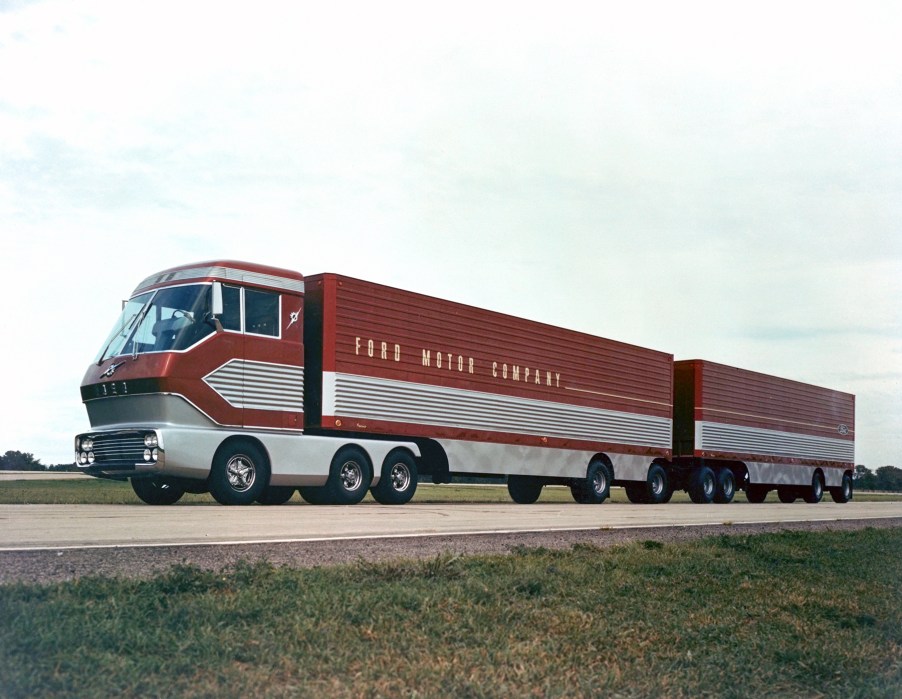
The Incredible Rediscovery of Ford’s 1-of-1 Turbine Semi-Truck
History is littered with lost automotive treasures. Cars like the Bugatti ‘La Voiture Noire,’ despite or because of their value, have sometimes disappeared. Or, as is sometimes the case with concept cars, the spotlight faded, and they were discarded and forgotten. But occasionally, these missing masterpieces get found. This is exactly what happened to the long-thought-lost Ford ‘Big Red’ turbine truck.
Turbine engines were supposed to be the future of transportation

It might seem odd today, but once upon a time, more than a few automakers thought using turbine engines was the way to go. For example, several IndyCar teams experimented with turbine-powered race cars, Autoweek and Road & Track report. And Chrysler famously put one, the 1963 Turbine, into semi-production.
However, after making 55 examples for ordinary people to test, Chrysler crushed all but nine of them. And while automakers have toyed with turbine engines since then, jet-powered cars have mostly been kooky one-off builds. But what made turbine engines so appealing back in the ‘50s and ‘60s?
To understand, it’s important to know how they work. Regardless of what fuel they burn, all turbine engines operate on the same basic principles, The Drive explains. In the center of each engine is a compartment where the fuel burns. The burning fuel drives a turbine fan connected to an exterior compressor fan with a shaft. As the turbine fan spins, it also turns the compressor fan which sucks in air and pressurizes it. That way, the fuel continues to burn and the turbine engine keeps making power.
Turbine engines have several advantages over conventional piston engines, Hagerty reports. They’re simpler, quieter, and smoother, and don’t wear as quickly. They also start more easily, require less maintenance, and produce plenty of torque, Hagerty and R&T report. Plus, they can run on practically any flammable substance: alcohol, kerosene, diesel, and even coal, Roadshow reports.

However, they also have several disadvantages. Turbine engines are rather expensive, and the Chrysler Turbine’s engine wasn’t particularly powerful. They also have poor fuel economy, Hagerty reports. And ironically, given the period, turbine engines can’t run on leaded gasoline, because it damages the fan blades.
Ford made one working turbine truck, ‘Big Red,’ and it’s been presumed lost

In the early 1960s, though, automakers focused more on the pros than the cons, especially when it came to Jet Age tech. This is why, like today, Ford and Chevrolet were trying to one-up each other’s trucks, The Drive explains. Specifically, by being the first to make a turbine-powered semi-truck. And by using carefully selected gear ratios and cheaper fuels, theoretically, these turbine trucks would be refined, reliable, and quiet.
In the end, Ford was the first to unveil a working prototype. At the 1964 World’s Fair, alongside the first Mustang, Ford revealed ‘Big Red,’ a 96-foot long, 13-foot-tall turbine truck with matching trailers, The Drive reports. And the gas turbine engine was just the start of what this truck offered.

Big Red’s cabin has a built-in TV with a reclining seat for the co-driver, Hagerty reports. And, in an early safety nod, only the co-driver can see the screen. The Ford turbine truck also has a power-folding ladder, a bathroom, and a stove, Autoblog reports. Plus, air suspension and redundant braking systems, The Drive reports.
Unfortunately, no amount of fancy features was going to save the turbine engine. And so, Ford planned to have Big Red scrapped. Except it wasn’t. Instead, it somehow ended up in the hands of Holman-Moody, Ford’s factory-sponsored race team, albeit with a V8 instead of the original turbine engine. However, here’s where the story of the Ford turbine truck gets murky.
Moody kept the semi-truck until 1978, when he sold it due to financial difficulties, The Drive reports. But while someone bought it, no one knew who or where the truck ended up. And while Moody had Big Red, the team didn’t have the matching trailers.
But after over 40 years, Big Red has been found
Ever since that sale, rumors have swirled around the Internet about the location of the Ford turbine truck. Rather like Bigfoot, some claimed to have seen it here, or there, or maybe in that secret garage, and so on. However, after about a year of digging, The Drive found Big Red—not in a junkyard, but restored and semi-working condition. And the true story is arguably better than the fiction.
Firstly, it was an act of pure coincidence that Big Red survived at all. Ford toured the turbine truck around the country, but at one Atlanta show, it needed its fluids drained. That included the oil. But when a driver from Detroit went to drive it back, he didn’t know that. And when he went to start it up, he melted the engine. So, Ford sent a wrecker to tow Big Red back to Detroit—and the wrecker broke down.
Luckily, that wrecker broke down close to Holman-Moody’s building near Charlotte, The Drive reports, and the team agreed to temporarily store it. Well, ‘temporarily’ turned to ‘permanently’ when Ford abruptly canceled its contract with the team. But because of Big Red’s size and its lack of engine, it just sat in the warehouse until the team sold it.
Luckily, Big Red’s current owner was “fascinated by the turbine truck since its dazzling World’s Fair debut,” The Drive reports. And after buying the truck, he slowly and painstakingly restored it. That included tracking down a genuine Ford turbine engine and bringing in Big Red’s original caretaker to help, The Drive reports. The powertrain’s extreme rarity means the Ford turbine truck hasn’t been driven since 2000. However, the owner claims it can “fire right back up with a little TLC,” The Drive reports.
True, some details remain lost to history. But despite it all, Ford’s incredible turbine engine truck is still kicking.
Follow more updates from MotorBiscuit on our Facebook page.


